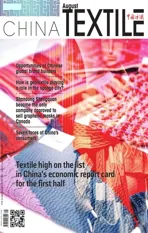Dear readers:
2021-11-22ZhaoHong
When the two hottest months of the year faded away, we leave July and August behind and move on to Autumn, a cool season in climatologic terms, but not in clinical terms as new wave of COVID—19 cases heats up in many provinces across the country, threatening to hinder economic growth that promises an enthusiastic prospect this year as forecast earlier.
Even though China has been doing pretty well in taking preventative and control measures to curb the disease spread, the new Delta—variant has somehow found its way to permeate through the border and customs sieves either in travelers or in goods, giving rise to new surge of the virus spread that extends to the area coverage from one or two prov—inces to nearly 20, escalating the total confirmed cases to over 1200 from around 300 cases that have hovered around for a year with a decline trend.
While the clouds of worry are rising over its impact on the economic performance in the second half of the year, it does not necessarily cast any shadow on our fine—weather mood to look back to the first half that provides fueling confi—dence in tackling any problems cropping up on the journey.
National Bureau of Statistics announced the economic data to show GDP growth by 12.7% in the first six months,and by 5.3% increase over the comparable periods on the previous two—year average to take into account 2019 and 2020. As the dual—driver development strategy for both domestic and international markets runs in full gear, the expen—diture on the finished goods consumption ramped up to a new level to mark 61% for its contributing rate in gross do—mestic product (GDP), resulting in 7.8 percentage points growth share in GDP totality, in an impressive contrast with the export, which has pushed up the total economic growth by 2.4 percentage points.
In the context of the overall macroeconomic development, the textile industry has performed very well in the first half of the year with its total business income to curve up by 20.3% and its profit by 41.1%. In the domestic market, the retails for textiles and apparel in brick—and—mortar shops grew by 33.7% while the online sales for the wearable chopped up by 24.1%, meanwhile, the international market for Chinese textiles and apparel was brimming with increasing de—mand, which led to 12.1% growth with 140.09 billion dollars worth of our textiles and apparel shipped out.
U.S. market remains strong for Chinese textiles and apparel in the first two quarters, witnessing 32.16% growth to amount to $12.696 billion imports, despite the fallout in U.S. market share which showed 27.9% as of June this year, a terrific downslide if we trace back to approx.40% that had stood firm for years. Will this market share change to the de—mand as Biden’s Administration adopts a China Policy more confronting than encouraging? I have noticed that Secretary Blinken has, more often than not, said that “the U.S. relationship with China will be collaborative where it can be, com—petitive where it should be, and adversarial where it must be. ” With this all set, how could we industrialists and business people sort out the area of business interest out of this preposterous trichotomy when this policy is intended to focus more on competition and conflict? I believe, in textile business, there were, are and will certainly be area of common in—terest where consumers and manufacturers in both countries are collaborative, cooperative and reciprocal. Confident, we shall weather the storm.
杂志排行
China Textile的其它文章
- Textile high on the list in China’s economic report card for the first half
- China’s cotton textile industry climate index report in June
- Texworld Evolution Paris - Le Showroom A new kind of sourcing
- Updates
- U.S. apparel and textile makers expect economic and job growth in 2021
- Global cotton prices to rise to USD 1.72 per kg in 2021
